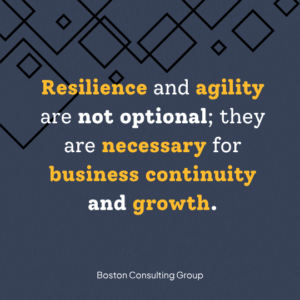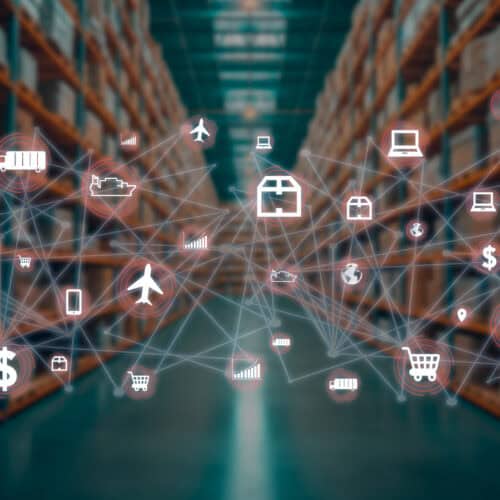AI in supply chain management is redefining how businesses prepare for and respond to disruption. From raw material shortages to labor strikes, today’s supply chains face a constant state of volatility and legacy tools can’t keep up.
AI gives planners and decision-makers the power to detect risk earlier, automate repetitive key decisions, and respond to changes with speed and confidence. AI-driven forecasting reduces errors by up to 50% and cuts inventory costs by 20%. These aren’t future benefits, they’re measurable outcomes that boost margin protection, customer service, and offer a competitive advantage. In this blog, we explore how AI builds the agility and resilience modern supply chains need to thrive under pressure.
The Case for Agility and Resilience
Supply chain resilience is the ability to recover quickly from disruptions, like a supplier shutdown or transportation bottleneck, without halting operations. Agility, on the other hand, is your supply chain’s ability to adjust quickly to shifting customer demands, supplier constraints, or market trends.
 While distinct, these two capabilities are closely connected:
While distinct, these two capabilities are closely connected:
- Resilience allows you to endure a disruption without breaking your chain.
- Agility enables you to pivot quickly, minimizing impact and capitalizing on opportunity.
These traits are no longer optional. Agility helps teams respond in real time to changing inputs, while resilience ensures they can absorb shocks and continue serving customers. Together, they protect service levels, reduce cost volatility, and enable faster recovery.
According to the Boston Consulting Group, organizations with stronger operational resilience recovered approximately 40% faster than their peers during the COVID-19 pandemic.
In today’s environment supply chains must be built not just for efficiency, but for adaptability. Resilience and agility matter because they give companies a better chance of avoiding disruption and recovering faster when it happens.
How AI Detects Disruptions Before They Happen
AI-powered systems use machine learning and real-time data to track supplier performance, logistics activity, and inventory signals across your supply chain. By identifying patterns and anomalies, like early shipment delays or imminent inventory gaps, AI alerts planners to risks before they escalate into costly disruptions.
Here are some uses cases:
- Port congestion detection: AI analyzes satellite imagery, vessel tracking, and weather data to forecast port delays. This allows companies to reroute shipments in advance and protect delivery timelines.
- Raw material risk alerts: AI continuously monitors pricing trends, supplier lead times, and market indicators to warn of potential shortages and suggest alternative sourcing.
- Transportation delays: In last-mile delivery, where logistics cost up to 41% of total supply chain spend, AI-driven routing tools dynamically adapt routes to traffic and carrier changes, cutting fuel use and delivery expenses.
These insights give supply chain teams the early visibility and agility they need to make faster, smarter decisions.
Where AI Adds the Most Value in Supply Chain Operations
AI enhances core supply chain functions that impact agility, responsiveness, and cost efficiency. Below are three key areas where AI delivers measurable improvements:
Demand Forecasting
AI forecasting tools analyze internal data such as order history and POS data, along with external signals like market trends, weather patterns, and economic indicators. This improves forecast accuracy at the SKU and location level, helping planners align supply with true customer demand.
Outcome: Better forecast accuracy, fewer stockouts, and more efficient planning cycles.
Inventory Optimization
AI recommends inventory levels that meet service targets without overstocking. It considers supplier lead times, demand variability, and item velocity to dynamically adjust reorder quantities. This improves cash flow and reduces working capital tied up in inventory.
Outcome: Reduced excess inventory, improved availability, and lower carrying costs.
Production and Distribution Planning
AI evaluates supply constraints, customer demand, and fulfillment windows to generate data-driven planning recommendations. These help planners prioritize what to produce or replenish first, especially when constraints like limited labor, long lead times, or transport delays exist.
Outcome: Faster response times, improved resource utilization, and more agile fulfillment.
3 Real-World Examples: How AI Improves Supply Chain Agility
Manufacturing: Real-Time Production Shifts with AI
Katty Fashion, a Romanian apparel manufacturer, is planning to use AI-powered digital twins to monitor its global supplier network to simulate production environments in real time. By integrating external signals like climate risks, news alerts, and raw material delays, the system can proactively recommend changes, such as shifting production lines or altering capacity, before a disruption. When flooding or political unrest threatens a key supplier region, the platform could automatically flag risks and support faster adaptation on the shop floor.
Consumer Goods: Adapting Production to Weather Spikes
Unilever’s ice cream division uses AI and weather forecasting to better align supply with weather-driven demand. According to the company, these AI-powered planning tools have improved forecast accuracy by 10%, helping teams more effectively adjust production and distribution. Unilever has also rolled out more than 100,000 AI-powered freezers that optimize stock levels and energy use based on real-time consumption data, improving performance across global markets.
This highlights how AI empowers supply chains to act on predictive signals, like weather forecasts, instead of reacting to data that is lagging. The ability to pivot in real time, both in production and last-mile inventory, is a core component of supply chain agility.
“Our ice cream teams can now adjust production lines and distribution before demand spikes, AI has made us significantly more agile.” — Elif Cakir, Supply Chain Lead, Unilever Ice Cream
Healthcare: Reducing Waste Across Multi-Site Inventory
Leading hospital systems including Mayo Clinic and Cleveland Clinic are deploying AI-powered inventory and replenishment systems to improve clinical supply chain efficiency. In 2019 alone, hospitals wasted approximately $25.7 billion in unused supplies, roughly $12.1 million per hospital. With AI, hospitals now automate purchase orders, invoice processing, and usage tracking, Cleveland Clinic reports that AI automation saves 20 minutes per transaction. These tools enable rapid adjustments to on-hand inventory across multiple locations, reducing waste, improving service levels, and increasing supply chain agility in real time.
“Our AI automation gives us agility. We can see things sooner and adjust faster because of our technology but also because of our talent.” — Joe Dudas, Division Chair of Supply Chain Strategy, Mayo Clinic
How to Start Building a Resilient, AI-Driven Supply Chain
You don’t need to overhaul your entire supply chain to begin using AI. Many companies start small, gain quick wins, and scale their efforts over time. Here’s how to begin:
Assess your data readiness
Clean, structured data is the foundation of AI. Start with demand, inventory, and supplier datasets.
Identify a pilot use case
Choose a focused area like demand forecasting or replenishment to prove value quickly.
Evaluate platforms
Work with solution providers that understand your industry and planning challenges.
Involve your team
Train planners and buyers early and show how AI enhances not replaces their expertise.
Build for scale
Use results from your pilot to build a business case and expand to other areas like transportation planning or supplier risk.
Ready to Strengthen Your Supply Chain Agility?
AI isn’t a future luxury; it’s a strategic necessity. As your supply chain landscape becomes more complex, using AI lets your team forecast with greater confidence, adjust inventory dynamically, and optimize production and fulfillment in real time. Whether you’re a planner piloting AI for the first time or an executive scaling across functions, the opportunity is to act with clarity and speed. Agility and resilience aren’t born from crisis, they’re built beforehand.
Explore AI-powered demand planning to see how your supply chain can become more responsive, efficient, and future-ready. Check out this eBook which touches on how you apply AI to your supply chain.
Frequently Asked Questions
What is AI supply chain management?
AI supply chain management is the use of artificial intelligence tools, like machine learning and predictive analytics to improve planning, forecasting, inventory, and logistics decisions across a supply chain.
What’s the difference between agility and resilience?
Agility refers to how quickly your supply chain can respond to change. Resilience is your ability to continue operating and recover after a disruption. Both are critical for long-term success.
How does AI detect supply chain disruptions?
AI monitors data in real time, detects patterns or anomalies, and sends alerts when something looks off, like a supplier delay or logistics bottleneck. This enables faster, proactive responses.
Which industries benefit most from AI in supply chains?
Industries with complex networks or fast-changing demand, such as manufacturing, automotive, wine and spirits, and healthcare, benefit significantly from AI’s forecasting and decision automation.
Related Posts


















